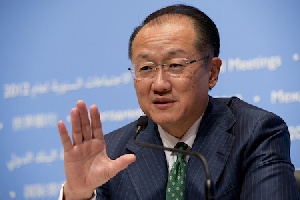The World Bank Group, in the next three years, will extend a credit facility of $1.2billion to Ghana out of a chunk allocated to Sub-Saharan Africa by the Bretton Wood Institution.
The facility, payable within 25 years with an interest rate of 2.5%, forms part of a $75billion credit for countries around the world.
Chief Economist for the Africa Region of the World Bank, Albert G. Zeufack, who disclosed this at a press briefing in Accra said Ghana has a four-year grace period to start repayment.
It is recalled that following a meeting with G20 finance ministers and central bank governors, World Bank Group President Jim Yong Kim announced a record $57 billion in financing for Sub-Saharan African countries over the next three fiscal years.
Kim left on a trip to Rwanda and Tanzania to emphasise the Bank Group’s support for the entire region.
The bulk of the financing – $45 billion – will come from the International Development Association (IDA), the World Bank Group’s fund for the poorest countries. The financing for Sub-Saharan Africa also will include an estimated $8 billion in private sector investments from the International Finance Corporation (IFC), a private sector arm of the Bank Group, and $4 billion in financing from International Bank for Reconstruction and Development, its non-concessional public sector arm.
In December, development partners agreed to a record $75 billion for IDA, a dramatic increase based on an innovative move to blend donor contributions to IDA with World Bank Group internal resources, and with funds raised through capital markets.
Sixty percent of the IDA financing is expected to go to Sub-Saharan Africa, home to more than half of the countries eligible for IDA financing. This funding is available for the period known as IDA18, which runs from July 1, 2017, to June 30, 2020.
“This represents an unprecedented opportunity to change the development trajectory of the countries in the region,” World Bank Group President Jim Yong Kim said. “With this commitment, we will work with our clients to substantially expand programs in education, basic health services, clean water and sanitation, agriculture, business climate, infrastructure, and institutional reform.”
The IDA financing for operations in Africa will be critical to addressing roadblocks that prevent the region from reaching its potential. To support countries’ development priorities, scaled-up investments will focus on tackling conflict, fragility, and violence; building resilience to crises including forced displacement, climate change, and pandemics; and reducing gender inequality.
Efforts will also promote governance and institution building, as well as jobs and economic transformation.
“This financing will help African countries continue to grow, create opportunities for their citizens, and build resilience to shocks and crises,” Kim said.
While much of the estimated $45 billion in IDA financing will be dedicated to country-specific programs, significant amounts will be available through special “windows” to finance regional initiatives and transformative projects, support refugees and their host communities, and help countries in the aftermath of crises.
This will be complemented by a newly established Private Sector Window (PSW)—especially important in Africa, where many sound investments go untapped due to lack of capital and perceived risks.
The Private Sector Window will supplement existing instruments of IFC and the Multilateral Investment Guarantee Agency (MIGA) – the Bank Group’s arm that offers political risk insurance and credit enhancement – to spur sound investments through de-risking, blended finance, and local currency lending.
This World Bank Group financing will support transformational projects during the FY18-20 period. IBRD priorities will include health, education, and infrastructure projects such as expanding water distribution and access to power.
The priorities for the private sector investment will include infrastructure, financial markets, and agribusiness. IFC also will deepen its engagement in fragile and conflict-affected states and increase climate-related investments.
Expected IDA outcomes include essential health and nutrition services for up to 400 million people, access to improved water sources for up to 45 million, and 5 GW of additional generation capacity for renewable energy.
The scaled-up IDA financing will build on a portfolio of 448 ongoing projects in Africa totaling about $50 billion. Of this, a $1.6 billion financing package is being developed to tackle the impending threat of famine in parts of Sub-Saharan Africa and other regions.
Business News of Sunday, 2 April 2017
Source: classfmonline.com

















